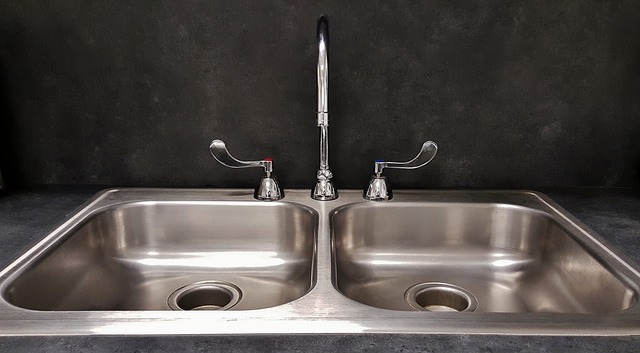The dullness of the stainless steel sink and the water stains that turn white are noticeable, but I don’t know how to polish it! Is it possible to restore a shiny stainless steel sink that is rough and has poor drainage? Here, we will introduce how to polish a stainless steel sink well and how to care for a stainless steel sink to keep it clean.
The appeal of stainless steel sinks
By the way, is your kitchen sink a stainless steel sink? Stainless steel sinks are one of the most popular materials because they are resistant to heat, shock, and dirt, and they can make your kitchen look stylish! When it was new, it was shiny and drained well, but gradually dirt and dullness became noticeable. If you make a mistake in how to clean and how to remove dirt, you may get extra dirty.
dirty stainless steel sink
Every time you cook or clean up after a meal, it’s natural for the sink to get dirty as you wash dishes that have oil and protein on them. Even if you clean it every day, food residue, water stains, and soap scum accumulate, and the stainless steel sink becomes a breeding ground for germs. If left unattended, it will cause black mold, whitening limescale stains, and dullness. Now, let’s take a look at how to remove water stains and dullness that turn white in the order that they’re gentle on stainless steel!
How to polish a stainless steel sink (1) Preparation
Remove all sink accessories, such as triangle corners, and apply Magiclean for greasy stains or a mild dish soap. You can’t judge the degree of dirt and scratches on the sink unless you remove the dullness of the limescale and oil film.
Recommended spongeScrub with a soft sponge and rinse with warm water. Isn’t this just a little cleaner?
How to polish a stainless steel sink ② Baking soda
Baking soda can easily remove rust from steel cans, stains from coffee and tea leaves, and light limescale that turns white after water droplets.
Recommended baking soda
Sprinkle water on the dirt and rub it with kitchen paper or cloth soaked in baking soda, and it will come off quickly. Since limescale is alkaline, it can be neutralized with citric acid to dissolve and remove it, but it takes time to soak. It is recommended to polish while removing other dirt.
Read Also: How to attach an indoor clothesline to the ceiling?
How to polish a stainless steel sink (3) Stainless cleaner
Stubborn stains on the sink that cannot be removed by polishing with baking soda can be cleaned with a stainless steel cleaner that can be used at home. Apply cleaner to a dry stainless steel sink and polish along the hairline (pattern on the stainless steel surface). At this time, it is effective to use a rolled wrap. Don’t forget to wear gloves to prevent rough hands as it is an acidic detergent!
How to polish a stainless steel sink (4) Sponge abrasive
A sponge abrasive that can be said to be the last resort that can be done at home. The grade of polishing is adjusted according to the degree of dirt, and is polished in order from coarse to fine. Even the corners of the sink, where dirt tends to accumulate, fit well with the sponge abrasive! Even sinks that you gave up thinking they’re useless will be restored to their original condition like new.
Polishing method not recommended
NG ① Use a strong acidic cleaning agent
For stubborn limescale stains, you will want to use a strong cleaning agent. However, if you use a strong acidic toilet cleaner against water stains on a stainless steel sink, it will turn black with vinegar. If it gets vinegar-burned, it will not come off unless it is polished by a professional. It is a good idea to use cleaning agents that match the degree of dirt in order of least burden.
NG② Special resin processing on the surface
Some stainless steel sinks in the latest kitchens are coated with a resin component that is invisible but repels water and dirt. The use of both acidic and alkaline solvents, as well as polishing, is prohibited. Even if the dirt is removed, the water repellent effect will be lost and the dirt will stick easily, so be careful.
NG ③ Polish in all directions
Let’s check the type of surface finish of the stainless steel sink. There are various types such as mirror surface, matte, vibration, and hairline. When finishing with stainless steel cleaner (abrasive 20% alumina-based minerals) or sponge abrasive, the surface is scraped to some extent, so polishing marks are left. Polishing stainless steel with a mirror finish requires a skilled technique.
Caring for a Stainless Sink
Finished the big cleaning so far, the sink became shiny. Stainless steel, which is inherently resistant to stains, can be kept clean for a long time if water stains and oil stains can be removed once a day. Here’s how to clean your kitchen sink at the end of the day in 3 steps! Once you get used to it, you can do it in 3 minutes.
Step 1 Empty the sink
Move small objects away to clean the sink. Daily cleaning is easier if you reduce the number of small items as much as possible!
Step 2: Wash with detergent and rinse with hot water
Lather up dishwashing liquid with a soft sponge and wash the inside of the sink. Rinsing with hot water is effective.
Step 3 Wipe off the water droplets
Wipe off with a cloth that can absorb water well. This will help prevent white water stains.
summary
We introduced how to remove limescale that turns the kitchen sink white, how to remove dullness, and how to keep the stainless steel sink clean. How was it? You can restore the luster of the mirror-finished faucet lever by wiping it with alcohol.
